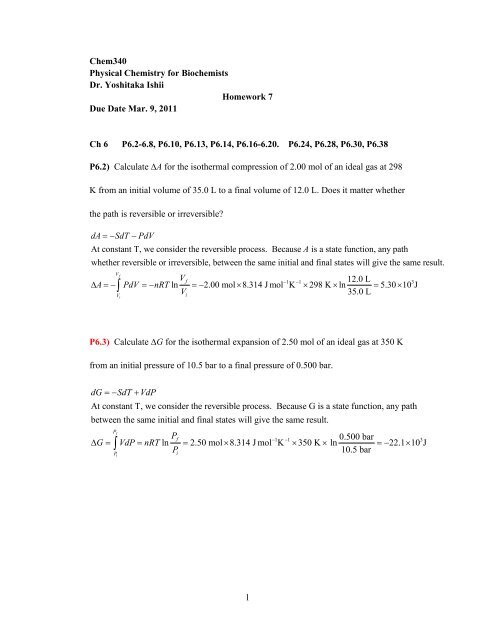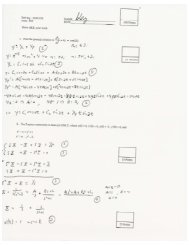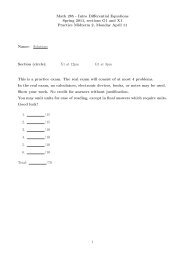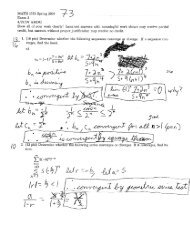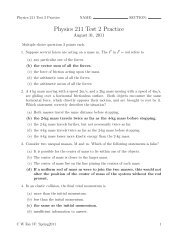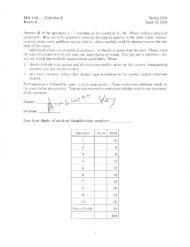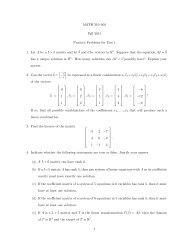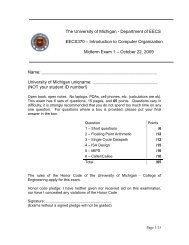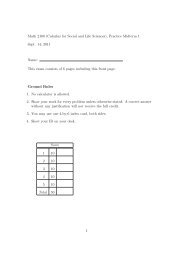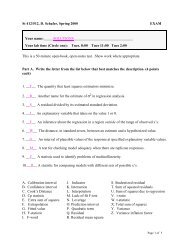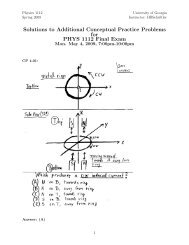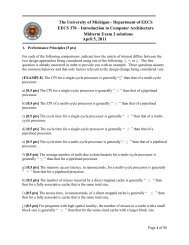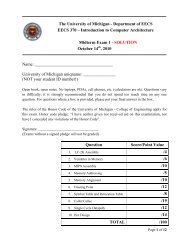HW#7 & Key (2011) – Physical Chemistry for Biochemists 1
HW#7 & Key (2011) – Physical Chemistry for Biochemists 1
HW#7 & Key (2011) – Physical Chemistry for Biochemists 1
Create successful ePaper yourself
Turn your PDF publications into a flip-book with our unique Google optimized e-Paper software.
Chem340<strong>Physical</strong> <strong>Chemistry</strong> <strong>for</strong> <strong>Biochemists</strong>Dr. Yoshitaka IshiiHomework 7Due Date Mar. 9, <strong>2011</strong>Ch 6 P6.2-6.8, P6.10, P6.13, P6.14, P6.16-6.20. P6.24, P6.28, P6.30, P6.38P6.2) Calculate A <strong>for</strong> the isothermal compression of 2.00 mol of an ideal gas at 298K from an initial volume of 35.0 L to a final volume of 12.0 L. Does it matter whetherthe path is reversible or irreversible?dA SdT PdVAt constant T, we consider the reversible process. Because A is a state function, any pathwhether reversible or irreversible, between the same initial and final states will give the same result.VfV12.0 LA PdV nRT V35.0 LVif1 1 3ln 2.00 mol 8.314 J mol K 298 K ln 5.30 10 JiP6.3) Calculate G <strong>for</strong> the isothermal expansion of 2.50 mol of an ideal gas at 350 Kfrom an initial pressure of 10.5 bar to a final pressure of 0.500 bar.dG SdT VdPAt constant T, we consider the reversible process. Because G is a state function, any pathbetween the same initial and final states will give the same result.PfPf1 1 0.500 bar3G VdP nRTln 2.50 mol 8.314 J mol K 350 K ln 22.110JP10.5 barPii1
P6.4) A sample containing 2.50 mol of an ideal gas at 298 K is expanded from aninitial volume of 10.0 L to a final volume of 50.0 L. Calculate G and A <strong>for</strong> thisprocess <strong>for</strong> (a) an isothermal reversible path and (b) an isothermal expansion against aconstant external pressure of 0.750 bar. Explain why G and A do or do not differfrom one another.a) <strong>for</strong> the isothermal reversible pathPfPfViG VdP nRT ln nRTlnPiiVPf1 1 10.0 L32.50 mol 8.314 J mol K 298 K ln 9.97 10 J50.0 LV fVfA PdV nRTlnVVii1 1 50.0 L32.50 mol 8.314 J mol K 298 K ln 9.97 10 J10.0 Lb) Because A and G are state functions, the answers are the same as to part a) becausethe systems go between the same initial and final states, T,V i → T,V f .G <strong>–</strong> A = H <strong>–</strong> U = (PV) = (nRT). There<strong>for</strong>e, G = A <strong>for</strong> an ideal gas if T isconstant.P6.5) The pressure dependence of G is quite different <strong>for</strong> gases and condensedphases. Calculate G m (C, solid, graphite, 100 bar, 298.15 K) and G m (He, g, 100 bar,298.15 K) relative to their standard state values. By what factor is the change in G mgreater <strong>for</strong> He than <strong>for</strong> graphite?2
For a solid or liquid,PfG VdPV P PPi312.011 10 kg50 99.0 10 Pa = 52.8 J3M Gm( C, s,100 bar) Gm( C, s,1 bar) Vm Pf Pi Gm( C, s,1 bar) Pf Pi 2250 kg mTreating He as an ideal gas,mf , ,100 bar , ,1 barG He g G He g VdPimP100 bar P1 barPfPif1 1 30 RT ln 1 mole 8.314 J mol K 298.15 K ln =11.4 10 JiThis result is a factor of 216 greater than that <strong>for</strong> graphite.P6.6) Assuming that H f is constant in the interval from 275 to 600 K, calculateG <strong>for</strong> the process (H 2 O, g, 298 K) (H 2 O, g, 525 K).G f( H 2 O, g, 525 K).GfT11 1 GfT2T2 H f T1T 1 T2 T 13 1228.610 J mol 3 1 1 1 525 K 241.810 J mol 298.15 K 525 K 298.15 KG525 K 218.510 J molf3 1P6.7) Calculate G reaction<strong>for</strong> the reaction CO(g) + 1/2 O 2 (g) CO 2 (g) at 298.15K. Calculate G reactionat 650 K assuming that H reactionis constant in thetemperature interval of interest. 1 Greaction Gf 2g Gf g Gf2g23 1 3 1394.4 10 J mol + 137.210 J mol 03 1257.2 10 J mol298.15 K CO , CO, O , 3
1 Hreaction K H f 2g H fg H f 2g23 1 3 1393.510 J mol + 110.510 J mol 0298.15 CO , CO, O , 283.010 J mol3 1 GreactionT11 1 GreactionT2T2 HreactionT1 T1 T2 T13 1257.2 10 J mol 3 1 1 1 G reaction 650 K650 K 283.0 10 J mol 298.15 K 650 K 298.15 K226.810 J mol3 1P6.8) Calculate A reactionand G reaction<strong>for</strong> the reaction CH 4 (g) + 2O 2 (g) CO 2 (g) + 2H 2 O(l) at 298 K from the combustion enthalpy of methane and theentropies of the reactants and products.All reactants and products are treated as ideal gases Gcombustion Hcombustion TScombustion ScombustionS CO 2, g2S H2O, lS CH 4, g2S O 2,g1 1 1 1 1 1 1 1213.8 J mol K + 270.0 J mol K 186.3 J mol K 2205.2 J mol K1 1242.9 J mol K3G890.310 J mol 298.15 K 242.7 J mol K 817.910 J molcombustion A U TS1 1 1 3 1 combustion combustion combustionHcombustionPVTScombustion combustion Gcombustion TScombustion PVTScombustionGcombustionnRTwhere nis the change in the number of moles of gas phase species in the reaction3 1 817.9 10 J mol 28.314J mol 1 K 1 298.15 K3 1A812.910 J molcombustionP6.10) The standard Gibbs energy of <strong>for</strong>mation G f <strong>for</strong> carbon dioxide gas is<strong>–</strong>394.4 kJ mol <strong>–</strong>1 . Calculate the Gibbs energy of <strong>for</strong>mation of carbon dioxide at itsnormal sea level partial pressure of 0.00031 atm.4
P6.14) Consider the equilibriumNO 2 (g) NO(g) + ½ O 2One mole of NO 2 (g) is placed in a vessel and allowed to come to equilibrium at a totalpressure of 1 bar. An analysis of the contents of the vessel gives the following results:T 700K 800KP(NO)/P(NO 2 ) 0.872 2.50a. Calculate K P at 700 and 800 K.KKpp[ NO][O2](700K)[ NO ][ NO][O2](800K)[ NO ]221212[ PNO][ PO]2[ P ]NO2[ PNO][ PO]2[ P ]NO21212[0.872][0.872][1][2.5][2.5][1]1212 3.952 0.934b. Calculate0 G reactionat 298.15K assuming that0 H reactionis independent oftemperature.0 G RTln KP(700 ) -0.397 kJ mol -1700K0 G RTln KP(800 ) -9.140 kJ mol -1700KP6.16) Consider the reaction FeO(s) + CO(g) Fe(s) + CO 2 (g) <strong>for</strong> which K P isfound to have the following values:T 600 o C 1000 o CK P 0.9 0.396a. Calculate0 G reaction,0S reaction, and0 H reaction<strong>for</strong> this reaction at 600 o C. Assume6
that0 H reactionis independent of temperature.0 G RTln KP(873 ) -0.764 kJ mol -1873K0 G RTln KP(1273 ) -9.804 kJ mol -11273KUsing the Gibbs-Helmholtz equation:GT10T1GT GH T1T 2200T1 1 H T2GTG HTSH GSTH GS12731273H GS873873T 2201273873 1T21 T1 1 T1 1 22.6J/ K 22.6J/ K0 G 127312730G8738731127318731 29.53kJ/ molb. Calculate the mole fraction of CO 2 (g) present in the gas phase at 600 o C.KX[ P873K)[ P] [ CO ] [0.9] ] [ CO][1.0]CO( p2COn[0.9][0.9 1.0]CO2CO2ntotal0.470.900P6.17) If the reaction Fe 2N s 32H 2g2Fes NH 3 g comes toequilibrium at a total pressure of 1 bar, analysis of the gas shows that at 700 and 800K, P NH3P H2 2.165 and 1.083, respectively, if only H 2 (g) was initially present inthe gas phase and Fe 2 N(s) was in excess.a. Calculate K P at 700 and 800 K.7
. Calculate S reactionat 700 and 800 K and H reactionassuming that it isindependent of temperature.c. Calculate G reaction<strong>for</strong> this reaction at 298.15 K.a) FeN 2 (s) + 3/2 H 2 (g) 2Fe(s) + NH 3 (g)KPPPNH3H2/ P/ P3/2P total = 1 atm =PPNH3 H2At 700 K,1 atm = 2.165P P = 3.165H2 H2PH 2PH 2= 0.316 atm,PNH 3= 0.684 atmKP0.684(700 K) = =3.850.316 3/2At 800 K1 atm = 1.083P P = 2.083H2 H2PH 2PH 2= 0.480 atm,PNH 3= 0.520 atm0.520K 800 K 1.56P0.480 3/2b) Assume that H reactionis independent of temperatureKlnKPP800 K Hreaction 1 1 700 K R 800 K 700 K800 K700 K 1KPRlnKPHreaction 42.1 kJ mol 1 1 800 K 700 K8
P P HreactionGreactionG 700 K RTln K 700 K 7.81 kJ molreactionG 800 K RTln K 800 K 2.91 kJ molreaction700 KSreaction700 K 48.9 J mol K700 K1 1S800 K 48.9 J mol Kreaction111 1The values ofSreactionat 700 K and 800 K are nearly the same becauseGreaction HreactionHreaction 1 1 c) ln KP298.15 K ln KP700 K R 298.15 K 700 KG = ln 3.85 + 11.1reaction3 142.1 10 J mol 1 11 18.314 J mol K 298.15 K 700 K298.15 K RTln K 298.15 K= 8.314 J mol K 298.15 K 11.1= 27.5 kJ molP1 1 1P6.18) Many biological macromolecules undergo a transition called denaturation.Denaturation is a process whereby a structured, biological active molecule, called thenative <strong>for</strong>m, unfolds or becomes unstructured and biologically inactive. Theequilibrium is denatured unfolded native foldedFor a protein at pH = 2, the enthalpy change associated with denaturation is H° =418.0 kJ mol <strong>–</strong>1 and the entropy change is S° = 1.3 kJ K <strong>–</strong>1 mol <strong>–</strong>1 .a. Calculate the Gibbs energy change <strong>for</strong> the denaturation of the protein at pH = 2and T = 303 K. Assume the enthalpy and entropy are temperature independentbetween 298.15 and 303 K.b. Calculate the equilibrium constant <strong>for</strong> the denaturation of protein at pH = 2 and T9
= 303 K.c. Based on your answers <strong>for</strong> parts (a) and (b), is protein structurally stable at pH =2 and T = 303 K?a) We first need to calculate G den at 298 K:ΔGden-1-1 -1298 KΔH 298 K- T S 418000 J mol 1300 J mol K 298 K 30600 J mol1dendenThen ΔG reaction303 Kcan be calculated using:ΔGΔGreactionreactionT2 T 24098.97 J mol2ΔG reactionT1T1 ΔHreaction-1 30600 J mol 303 K 303 K -1298 K1T21T1-1 418.00 kJ mol 1 1 303 K 298 K b) The equilibrium constant at 303 K is:Kp303 K Exp G Exp R Tden-1 -124098.97 J mol J mol -1 -18.314472 J K mol 298 K5.97 10-5c) The large positive G den and the small equilibrium constant indicate that the proteinis stable.P6.19) The melting temperature of a protein is defined as the temperature at whichthe equilibrium constant <strong>for</strong> denaturation has the value K = 1. Assuming that theenthalpy of denaturation is temperature independent, use the in<strong>for</strong>mation in ProblemP6.18 to calculate the melting temperature of the protein at pH = 2.10
We first calculate the equilibrium constant at 298 K:Kp298 K Exp ΔG Exp0reaction-130600 J mol -1 -18.314472 J K mol 298 K298 KR TWe then solve <strong>for</strong> T m , with ln K T 4.32910 ln1 0pm :-6lnKTlnK298pmp0ΔHRreaction1Tm1298.15 K Tm1298.15 K 1 298.15 K 321.5 KRln1KTlnK298pmΔH10reaction-1 -1-68.314472 J K mol 0 ln4.32910-1418000 J mol pP6.20) Calculate the Gibbs energy change <strong>for</strong> the protein denaturation described inProblem 5.45 at T = 310.K and T = 340.K.From P5.45 we have:den-1 -1310 K 1109.4 J K molΔS ΔHΔHdenden-1 -1310 K343.9 kJ K mol-1 -1340 K640.1kJ K molΔG den310 K is then:ΔGden310 KΔH 310 KT ΔS 310 Kden-1-1 -1-1343.9 kJ mol 310 K1109.4 J K mol 0 kJ molAt 340 K we obtain:den11
GTGT 22003400GT1 1 1 HT 1T2T 1 0 (340) (340)(640.1) 310 13401 61.945kJ/ mol310 P6.24) At T = 298 K and pH=3 chymotrypsinogen denatures with G° = 30.5 kJmol <strong>–</strong>1 , H° = 163 kJ mol <strong>–</strong>1 , and C P,m = 8.36 kJ K <strong>–</strong>1 mol <strong>–</strong>1 . Determine G° <strong>for</strong> thedenaturation of chymotrypsinogen at T = 320. K and pH=3. Assume C P,m is constantbetween T = 298 K and T = 320. K.First, we calculate S 0 at T = 298 K:ΔS 298 K ΔG 298 K ΔH298 K-1-130.5 kJ mol 163 kJ mol 298 KT0.445kJ K-1mol-1To calculate G° at T = 320 K we need to calculate H and S at T = 320 K with aconstant C p,m : ΔH298 KΔH 320 K ΔCp,mΔT-1-1 -1-1163 kJ mol 8.36 kJ K mol 22 K346.92 kJ mol ΔS298 KΔS 320 K-1 -1-1 -1 320 K445 J K mol 8.36 kJ K mol ln 1040.46J K-1molG° at T = 320 K is then:-1 n ΔCp,m Tln T320298 ΔH320 KT ΔS320 KΔG 320 K298 K-1-1 -1-1346.92 kJ mol 320 K1040.46 J K mol 13.97 kJ mol12
P6.28) Calculate mixture O2298.15 K, 1 bar <strong>for</strong> oxygen in air, assuming that themole fraction of O 2 in air is 0.200.For pure O 2 :μO 2-1 -1-1pureΔG O T ΔS O 298.15 K205.2 J mol K 61180.38 J molFor O 2 in air:mmixμ pureμ OO R T ln xO 22m222-1-1 -1-161180.38 J mol 8.314472 J K mol 298.15 Kln0.200 65.2 kJ molP6.30) You have containers of pure H 2 and He at 298 K and 1 atm pressure.Calculate G mixing relative to the unmixed gases ofa. a mixture of 10 mol of H 2 and 10 mol of He.b. a mixture of 10 mol of H 2 and 20 mol of He.c. Calculate G mixing if 10 mol of pure He are added to the mixture of 10 mol of H 2and 10 mol of He.1 1 1 12 2 2 21 1a) Gmixing 20 mol 8.314 J K mol 298 K ln ln 34.4 kJ1 1 2 23 3 3 31 1b) Gmixing30 mol 8.314 J K mol 298 K ln ln 47.3 kJGmixing G10 mol A + 10 mol Bc) Gpure gasesmixingmixing= 47.3 34.4 12.9 kJP6.38) Consider the equilibrium in the reaction 3O 2 g2O 3 g, withH reaction 285.4 10 3 J mol 1 at 298 K. Assume that H reactionis independent oftemperature.13
a. Without doing a calculation, predict whether the equilibrium position will shifttoward reactants or products as the pressure is increased.b. Without doing a calculation, predict whether the equilibrium position will shifttoward reactants or products as the temperature is increased.c. Calculate K P at 550 K.d. Calculate K x at 550 K and 0.500 bar.a) Since the number of moles on the product side (2) is smaller than on the reactantside (3), increasing the pressure would shift the equilibrium towards the product side.b) Since the reaction is endothermic (ΔH > 0), increasing the temperature would shiftthe equilibrium towards the products.c) To obtain K p at 550 K, first K p at 298.15 has to be calculated. This requires thecalculation of ΔSΔSKp reaction ExpThen:reaction, and subsequentlyΔGreactionat 298.15 K:-1 -1-1 -1-1 -1298.15 K ν S 2 238.9 J K mol 3205.2 J K mol -137.8 J K mol ΔG 298.15 K 298.15 K ExpR T iif,i3 -1-1 -1285.410J mol 298.15K137.8 J K mol -1 -18.314472 J mol K 550 K14 5.9865103 -1 285.410J mol 1 1550 K Expln298.15 K -1 -8.314472 J mol K 550 K 298.15 K 4.9810K p1d) K x at 550 K and 0.500 bar with = 1 is given by:K-Δ1 p 0.5 bar x Kp Kp 2 Kp 210 p 1.0 bar A/ T 235354.98109.96 Q1. Prove that U/ T and . They (T ) TV (1/) Vare also known as Gibbs-Helmholtz equations. Write an expression analogous to Eq.(6.37) to relate A at two temperatures. (Modified from P6.27).A/ T U-5835
A/ T (T ) (1/T ) V1 A T TA/ T A/ T T A/ T VT2 T2T1 T1At constant V , AT TA Ud d T T VASAA TS 222T T T TV (1/T ) AT2 1 1 1 U T1 T2 T1 T2 T1V T2TV U/ T U215
Q2. Figure 6.8 in p126 depicts the total Gibbs energy <strong>for</strong> a mixture of NO 2 (g) andN 2 O 4 (g) at a different ratio in its equilibrium between (2 -2 ξ) mole of NO 2 and ξmole of N 2 O 4 (g) at a constant pressure and temperature at 1 bar and 298 K. (a)Reproduce the plots <strong>for</strong> G pure and G mixture assuming that G m 0 (NO 2 , g) = -38.45 kJmol-1 and G m 0 (N 2 O 4 , g) = -79.60 kJmol -1 . (b) Explain how you obtained the equationsto calculate G pure and G mixture . (c) How much is ξ in the equilibrium state.(Modified from P6.41)(a)-77-78G pureG(kJ mol -1 )-79-80G mixture-81=0.72,G=-81.0kJ mol -10.0 0.2 0.4 0.6 0.8 1.0(b)G (2 - 2) G (-79.60 kJ molGpuremixture Gpureom ΔG( NO, g) G) -76.90 kJ molmixing Gpure2 22 2 Gpure (2 -) RT ( ln ln )2 2 2 2 -1-13 -76.90 kJ mol 2.70kJmol 8.31447210 298kJ mol 2 2 (2 - 2)ln ln 2 2 -12om( N24-1 nRT ( xO , g) (2 - 2) (-38.45 kJ mol 2.70kJmolNO2ln xNO2 x-1N2O4ln xN2O4-1)-1)(c) At the equilibrium state, G mixture has a minimum is at = 0.72.16
Q3. Plot G mixture (ξ) at 350K <strong>for</strong> the system described in Q2 (assume that the totalpressure is 1 bar). Does T affect ξ in the equilibrium state? (Hint: first, obtainG 0 m (NO 2 , g) and G 0 m (N 2 O 4 , g) at T = 400K.)GGGomom( NO22( N Omixture -125.94 kJ mol350K oo1 1, g,350K) Gm( NO2, g,298K) 350K ΔHf( NO2, g)(- )298K350K298K350K-1-1 1 1 (-38.45 kJ mol ) 350K (33.2 kJ mol )( - )298K350K298K-1 -50.95kJ mol350K oo1 1, g,350K) Gm( N2O4, g,298K) 350K ΔHf( N2O4, g)(-298K350K298K350K-1-1 1 1 (-50.95 kJ mol ) 350K (11.1kJ mol )( - )298K350K298K-1 -95.43kJ mol4 G (2 - 2) Gpureom ΔG( NO (2 - 2) (-50.95 kJ mol-101.91kJ mol G, g,350K) G 6.49kJmol2 22 2 (2 -) RT ( ln ln )2 2 2 2 15.3kJmol 2 2 (2 - 2)ln ln 2 2 2-1-1mixing-1pure nRT(xom( Nln x) (-95.43 kJ mol-1-12NO24NO2-1 8.31447210 x) nRT ( x3N2O4ln xO , g,350K) nRT ( xNO2NO2 350kJ molN2O4)ln xln x-1NO2NO2 x xN2O4N2O4ln xln x)N2O4N2O4))T affects ξ of this reaction, ξ eq corresponds to ξ~0.16.17


